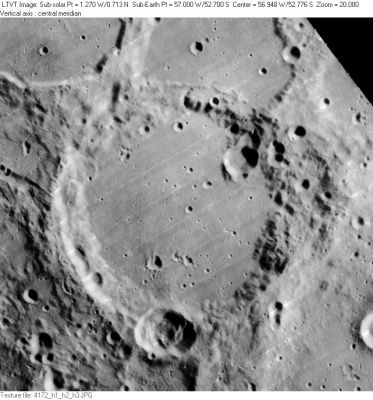Phocylides
Contents
[hide]Phocylides
|
Lat: 52.7°S, Long: 57.0°W, Diam: 121 km, Depth: 3 km, Rükl 70 |
LO-IV-172H Phocylides is in the center. In the northeast it overlies 76-km Nasmyth. The 15-km crater on the northeast floor (below Nasmyth) is Phocylides N. Opposite these, in the southwest, 23-km Phocylides F straddles the main crater rim, followed by partially visible 32-km Phocylides E. The large crater (with the dark-haloed one on its floor) partially visible in the upper left is Wargentin.
Images
LPOD Photo Gallery Lunar Orbiter Images
Maps
(LAC zone 124B3) USGS Digital Atlas PDF
Description
Description: Elger
(IAU Directions) PHOCYLIDES.--This extraordinary walled plain, with its neighbouring enclosures, is structurally very remarkable and suggestive. It consists of a large irregular formation, with a lofty wall, flanked on the N. by a smaller and still more irregular enclosure (b), the floor of which is 1,500 feet above that of Phocylides, the line of partition being a high cliff, probably representing a "fault," whose shadow under a low sun is very striking. Phocylides is about 80 miles in maximum length, or, if we reckon the small enclosure b to form a part of it, more than 120 miles. The loftiest peak, nearly 9,000 feet, is on the E. border, near the partition wall. The continuity of the rampart is broken on the S. by a large crater. There is a bright ring-plain on the E. side of the floor, and a few small craters. Phocylides b has only a solitary crater within it. Phocylides C, abutting on the E. flank of Phocylides, is about 26 miles in diameter. Its somewhat dusky interior is devoid of detail, but the outer slope of its E. wall is crowded with a number of minute craters, which, under good conditions, may be utilised as tests of the defining power of the telescope used. Phocylides A, on the bright S.E. plain, is a large deep crater with a fine crater-row flanking it on the E.
Description: Wikipedia
Additional Information
- Depth data from Kurt Fisher database
- Westfall, 2000: 3 km
- Cherrington, 1969: 2.1 km
- The Nasmyth-Phocylides fault: A play of shadow and light
- Left: DEM (Digital Elevation Model) view of Nasmyth and Phocylides as seen by an observer from Earth (projection made using LTVT).
- Middle Left: Aerial DEM view of left image (LTVT projected).
- Middle Right: Clementine aerial view of Nasmyth and Phocylides (LTVT projected).
- Right: Elevation map (yellow = highs, green = lows) on DEM view (LTVT projected).
- The distinct straight demarcation line between craters Nasmyth and Phocylides is easily seen in the above images during a waxing-gibbous (~ 12 day-old moon), low sun-angle apparition. During such occassions, the floor of Nasmyth remains almost fully bathed in sunlight, while the floor of Phocylides is, with the exception of a few high points, completely shadow-filled. It was this play of shadow and light between the higher floor of Nasmyth (at top of middle-left image) and the much lower floor (~ 1,500 feet) of Phocylides that a straight line of partition between the two suggested that a 'step fault' may exist. A step fault occurs when several blocks parallel to each other move downwards due to tension in the crust; resulting in a step-like formation with one main level (e.g. the floor of Phocylides) being lower than the adjacent higher level (e.g. the floor of Nasmyth). In his 1895 book 'The Moon: A Full Description and Map of its Principal Physical Features' Elger notes that "In Phocylides, probably through "faulting," one portion of the interior suddenly sinks to a considerable depth below the remainder,". For over half a century, the question remained unanswered as to the true nature of the unusual shadow-light appearance between both craters until in the 1950s when revised research carried out by Whitaker showed that the demarcation line was likely due to a high western wall (today's eastern wall) in Nasmyth casting a straight-edged shadow. This may in fact be the case as higher sun-angle views on DEMs using LTVT show the south-eastern rim (modern cardinal notation) of Nasmyth to be particularly higher there (see right-most image of elevations). Another interesting proposal by Larson Milling in his 1959 Irish Astronomical Journal paper suggested that the effect may occur because of the nearby flooded crater Wargentin (seen in the north-western corner of the Clementine image above). Milling points to the fact that as the "unique filled-to-the-brim crater" may have breached its western wall (today, its eastern wall) with lava-flows, Nasmyth's initial low-lying floor became raised by these deposits above that of Phocylides's floor producing the demarcation 'fault-like' effect. A look at both the Clementine and LOLA views above, the floor of Nasmyth is much higher than Phocylides's floor, and as both Wargentin and Phocylides are younger than Nasmyth, some flow-dynamics of lava (or ejecta deposits) may have played a role in Nasmyth's final raised floor. Whatever the occurrence of events the 'fault', as believed back then, does not exist today and the demarcation shadow-line effect between the two craters is merely due to lower-higher levels from subsequent lava-flow (ejecta?) deposits as mentioned above. - JohnMoore2
Nomenclature
Johannes Phocylides Holwarda (Jan Fokker); Dutch astronomer (1618-1651).
- According to Whitaker (p. 214), this name appeared on Riccioli's map, but included the modern Nasmyth.
LPOD Articles
Bibliography
A Portfolio of Lunar Drawings (Harold Hill), pages 160, 161.
Milling, L. (1959). Two Lunar Formations - Irish Astronomical Journal, Vol. 5(6), pp 174-176, 1959.

